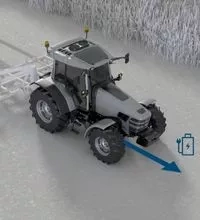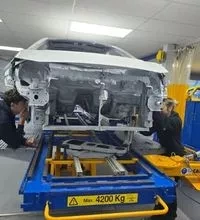How to get your truck wheels straight
What’s in this article: Wheel alignment issues in commercial vehicles can make them inefficient, but regular servicing can reduce the impact
It’s hard life for truck wheels, bumped up over kerbs as drivers get as close as possible to their delivery point, and regularly walloped by potholes.
Sent scrabbling down un-surfaced roads to the bottom of a quarry, they get an extra-hard hammering if they are attached to tippers. If the vehicle that is running on them is transporting rubbish, then sooner or later they will have to brave a landfill site.
So it isn’t surprising that they are periodically knocked out of alignment. What is more surprising is how infrequently alignment is checked.
"In the UK transport fleets seem to pursue a reactive rather than a proactive approach," says Tom Coad, technical demonstrator at Automotive Equipment Solutions (AES). "They only carry out a check if they happen to spot that a truck's tyres are wearing unevenly."
Failure to check alignment regularly can be expensive. "It can add 3% to your fuel bill and 10% to your tyre costs," he warns.
Alignment specialist Steertrak says that poor alignment can worsen fuel economy by nearly 4%.
These warnings are supported by real-world data compiled by the Department for Transport's Freight Best Practice programme some years back. It suggests that AES and Steertrak are if anything understating their cases, with fuel savings approaching 19% a possibility depending on how far out of alignment the wheels are.
The programme's figures go on to suggest that regular attention to alignment can result in steer axle tyres lasting 22% longer and drive axle tyres having their lives extended by more than 10%.
"Misaligned wheels can soon render a set of tyres illegal," points out Chassis and Cab Specialists director, Alex Adshead. Based in Leigh, Greater Manchester, the firm specialises in realigning truck chassis and cabs after they have been involved in a collision.
Misalignment affects a truck's handling and leads to drivers finishing their shift more tired than they should be. That’s because they are constantly fighting to keep the vehicle in a straight line.
So how regularly should alignment be checked? "At least once a year, and whenever tyres are replaced and steering and suspension parts changed," Coad says.
Some industry figures argue that alignment should be checked when a truck undergoes its statutory inspection. That could mean as often as every six weeks if it is 12 years old or more according to the Driver and Vehicle Standards Agency's latest Guide to maintaining roadworthiness.
Straight talk
Wheel alignment equipment does not come cheap. Well known equipment manufacturer Josam, offers a laser-based package that costs around £6,500.
Technicians using it will take 20 to 30 minutes to check the alignment of an 18-tonner, says Coad. "That of course assumes that they know what they are doing," he adds
The camera-based system that Josam also makes costs approximately £18,500 but enables the job to be done in only six or seven minutes. There’s also a system based on a high-speed rotating laser too which is even quicker, with the task completed in just four or five minutes.
Such speed comes at a price however; £28,000 to £32,000 in this case.
AES and Josam are not without their rivals. Among them are Absolute Alignment, which distributes a £10,000 aligner made by Ravaglioli that can be controlled using Bluetooth.
"It's quick and easy to use," insists Absolute technical director, Chris Dear.
Checking alignment is only part of the job. If misalignment is discovered, then the wheels have to be adjusted accordingly; and it can take up to an hour to complete the task on a truck.
When it rolls out of the workshop again however then it will burn less fuel; so the time and trouble taken will have been worthwhile.




